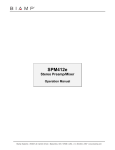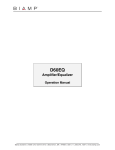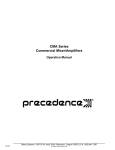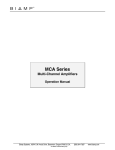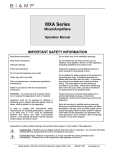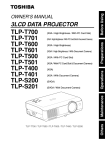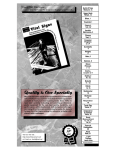Download Biamp AUTOONE Specifications
Transcript
SPM412e Stereo Preamp/Mixer Operation Manual Biamp Systems, 10074 S.W. Arctic Drive, Beaverton, Oregon 97005 U.S.A. (503) 641-7287 www.biamp.com blank 19Mar07 SPM412e INTRODUCTION TABLE OF CONTENTS Front Panel Features pg. 2 Rear Panel Features pg. 3 Modifications pg. 4 & 5 Remote Control pg. 6 & 7 Applications pgs. 8 & 9 Block Diagram pg. 10 Specifications pg. 11 Warranty The SPM412e Stereo Preamp/Mixer provides four stereo line inputs, one mic/line input, and two independent outputs. With input source selection, automatic page-over muting, and remote control functions, the SPM412e is ideally suited for applications such as restaurants, bars, meeting rooms, aerobics studios, and school gymnasiums. The SPM412e is extremely versatile, yet cost-effective, and is easy to install and operate. SPM412e features include: ♦ four stereo line inputs with trim controls & RCA connectors ♦ balanced mic/line input on plug-in barrier strip connector ♦ trim, pad, peak indicator, & level control on the mic/line input ♦ +24 volt phantom power switchable on the mic/line input ♦ balanced stereo main output on plug-in barrier strip connector ♦ balanced mono zone output on plug-in barrier strip connector ♦ front panel push-buttons select stereo inputs & adjust main level ♦ simultaneous selection of multiple stereo inputs from front panel ♦ front panel display shows stereo input selections & main level ♦ treble, bass, and balance controls for the stereo main output ♦ rear panel switch defeats treble & bass at stereo main output ♦ rear panel switch converts the stereo main output to mono ♦ limiter with threshold control for the stereo main output ♦ front panel rotary level control for the mono zone output ♦ automatic talkover muting when the mic/line input is in use ♦ internal jumpers assign mic/line input pre or post treble & bass ♦ internal jumpers assign mic/line input pre or post main level ♦ internal jumpers assign mic/line input to main and/or zone ♦ internal jumpers assign stereo line inputs to main and/or zone ♦ internal jumpers assign talkover muting to main and/or zone ♦ separate internal talkover mute adjustments for main and zone ♦ infrared, wall-mount, custom, or third-party remote controllers ♦ wall-mount ‘Controller’ overrides commands from front panel ♦ remote control affects stereo input selection & main level ♦ default settings can be defined & stored for recall at power-up ♦ incorporates AES recommended grounding practices ♦ marked and UL / C-UL listed power source ♦ covered by Biamp Systems' five-year warranty 1 FRONT PANEL FEATURES channel select down mute up min main level max SPM412e mic level (1) 1 3 2 (2) 4 bass treble balance zone level (3) (4) (5) (6) (7) (7) Main Level: These three momentary push-buttons adjust the overall level of signals sent to the Main Output (see Main Output on pg. 3). The Down push-button decreases level and the Up push-button increases level. As long as either push-button is being pressed, signal level will continue to change until the minimum or maximum level has been reached. It takes approximately five seconds to adjust from one extreme to the other. When the Mute push-button is pressed, the output is muted (turned off). Pressing the Mute push-button again will gradually un-mute the output. Pressing the Up push-button (while the output is muted) will immediately un-mute the output and begin increasing the level. However, Pressing the Down push-button (while the output is muted) will cause there to be a decreased level when the output is un-muted. Whenever power to the SPM412e is turned off or interrupted, Main Level settings (except Mute) are retained in non-volatile memory for recall when power is turned back on. However, a default level setting can be defined and stored for recall at power-up (see Power Switch below). The 9-segment LED display indicates the relative level setting for the Main Output. The display is not a signal level meter. The output has approximately 10dB of gain at ‘max’, 70dB of attenuation at ‘min’, and 0dB of gain (unity) when seven of the nine LEDs are lit. When Main Output is muted, only the ‘min’ LED will be lit. When Main Output is unmuted, the display will return to the current level setting. Pressing the Down button (while the output is muted) will cause there to be a decreased level when the output is un-muted, however, the display will remain at ‘min’ until the output is actually un-muted. NOTE: See Remote Control on page 6. (1) Mic Level: This rotary control adjusts the level of the Mic Input signal sent to the Main Output and Zone Output sections. Mic Input signal can be assigned to the Main and/or Zone Outputs individually, plus it can be assigned to the Main Output as pre/post Tone and pre/post Main Level (see Modifications on pgs. 4 & 5). (2) Channel Select: These four momentary push-buttons select which Stereo Line Input signal is sent to the Main Output and Zone Output sections (see Stereo Input Assign on pg. 4). To select a desired Stereo Line Input, press the corresponding push-button. The adjacent LED indicator will light, indicating the selection. More than one Stereo Line Input can be selected at a time by pressing the corresponding front panel push-buttons simultaneously. Whenever power to the SPM412e is turned off or interrupted, Channel Select settings are retained in non-volatile memory for recall when power is turned back on. However, default settings can be defined and stored for recall at power-up (see Power Switch below). NOTE: See Remote Control on page 6. (3) Bass: This rotary control adjusts the low-frequency (Bass) content of the Main Output signals. When this control is centered (12 o’clock), Bass is normal (flat). When turned counter-clockwise, Bass is decreased (-12dB @ 200Hz max.). When turned clockwise, Bass is increased (+12dB @ 200Hz max.). A rear panel switch allows the Bass & Treble controls to be bypassed (see Tone on pg. 3). (4) Treble: This rotary control adjusts the high-frequency (Treble) content of the Main Output signals. When this control is centered (12 o’clock), Treble is normal (flat). When turned counterclockwise, Treble is decreased (-12dB @ 5kHz max.). When turned clockwise, Treble is increased (+12dB @ 5kHz max.). A rear panel switch allows the Bass & Treble controls to be bypassed (see Tone on pg. 3). NOTE: Whenever power to the SPM412e is removed or interrupted, Channel Select & Main Level settings (except Mute) are retained in non-volatile memory for recall when power is restored. Default Channel Select and Main Level settings can be defined & stored for recall at power-up. To define & store default settings: 1) Select the default Stereo Line Input(s). 2) Adjust Main Level to the default setting. 3) Allow 3 seconds of inactivity (settings are stored in non-volatile memory). 4) Turn unit off (unplug from AC power). 5) Press and hold the Mute push-button while restoring power. 6) Release the Mute push-button. 7) Cycle power off & on again (confirms the default power-up settings are stored). These Channel Select & Main Level settings are now stored in non-volatile memory, and will be recalled whenever power to the SPM412e is turned off & on (interrupted). NOTE: This process can be reversed (so the SPM412e will again recall the most recent settings at power up) by repeating steps 4~7. (5) Balance: This rotary control adjusts the stereo balance of the Main Output signals. When this control is centered (12 o’clock), left and right signal levels are equal. When turned counterclockwise, left signal level increases and right signal level decreases. When turned clockwise, right signal level increases and left signal level decreases. Use the Balance control to compensate for uneven speaker coverage. (6) Zone Level: This rotary control adjusts the overall level of signals sent to the Zone Output (see Zone Output on pg. 3). 2 REAR PANEL FEATURES BIAMP SYSTEMS designed and assembled in the USA www.biamp.com R limit threshold input 4 level main L input 3 R level L input 2 R level L input 1 R level L R mute main signal L gnd gnd zone IR3 remote IR2 ~ 27V 50/60 Hz mic trim pad tone (1) (2) stereo mono (3) (4) phtm pwr +10 lo hi 15 watts class 2 wiring gnd limit (5) (6) out in bypass (7) (8) (9) off on (10) (11) (12) (8) Inputs 1~4: These RCA connectors provide the unbalanced Stereo Line Inputs for line-level signals (-10dBu or +4dBu). Use these inputs to accept signals from cassette, CD, VCR, tuner, satellite, cable, computer, etc. Inputs 1~4 each have a screwdriver adjustable control for setting level of the corresponding Stereo Line Input signal. Use these controls to compensate for different input signal levels. For best performance, reduce level only on inputs which are higher than the others. These controls are factory set fully clockwise for +10dB of gain. This is appropriate for most inputs such as CD, cassette, tuner, etc. (-10dBu nominal levels). (1) Power Cord: The external transformer provides 27 Volts AC to the SPM412e, and is detachable via a 5-pin DIN connector. Two internal ‘self-resetting’ fuses provide AC over-current fault protection (not user servicable). These fuses will attempt to re-set when power is turned off. If these fuses do not re-set, or continue to trip, it is an indication that the SPM412e requires service. (2) Remote: When the adjacent switch is released, the ‘IR2’, ‘IR3’, & ‘gnd’ terminals can be used for connection of optional remote controls (see Remote Control on pg. 6). When the adjacent switch is depressed, the ‘hi’, ‘lo’ & ‘gnd’ terminals can be used as a ‘Translator’ input for remote control via third-party controllers which utilize a carrier-stripped serial bit-stream (see Translator on pg. 7). (9) Mic / Line Input: This balanced input will accept either lowimpedance microphone or line-level input signals. For unbalanced use, connect signal to (+) and ground to both (d) & (-). Three additional terminals are provided for ‘page-over’ muting of the Stereo Line Input signals. By wiring ‘signal present’ to ‘mute’, automatic muting of the currently selected Stereo Line Input will occur whenever signal is present at the Mic/Line Input. Manual muting of the currently selected Stereo Line Input is achieved by wiring a switch or contact-closure between ‘mute’ and the adjacent ‘gnd’ terminal. From the factory, ‘page-over’ muting is set for -40dB, and is assigned to both the Main Output and the Zone Output (see Mute Assign & Mute Adjust on pg. 4). (3) Zone Output: This balanced output carries a mono sum of the selected Stereo Line Input signal, and the Mic/Line Input signal (see Modifications on pg. 4). Zone Output provides 6dB of additional gain when balanced. For unbalanced use, connect signal to (+) and ground to (d), leaving (-) unconnected. When Mic/Line Input signal is present, stereo input signal may be muted automatically by up to 40dB (see Mic/Line Input on this page). (4) Main Output: This balanced stereo output carries the selected Stereo Line Input signal, and the Mic/Line Input signal (see Modifications on pg. 4 & 5). Main Output provides 6dB of additional gain when balanced. For unbalanced use, connect signal to (+) and ground to (d), leaving (-) unconnected. When Mic/Line Input signal is present, stereo input signal may be muted automatically by up to 40dB (see Mic/Line Input on this page). (10) Pad: When depressed, this switch reduces the Mic/Line Input signal level by 30dB (see Mic/Line Input above). Use this switch when Mic/Line Input signal levels exceed the normal operating range of the Trim control, or whenever a line-level input signal is connected. (11) Trim: This screwdriver adjustable control sets gain at the Mic/Line Input (see Mic/Line Input above). Use this control to compensate for different input signal levels. For best performance, adjust Trim so the adjacent +10 indicator flashes only on occasional peaks in signal level. (5) Limit Threshold: This screwdriver adjustable control sets the threshold level for the internal limiter. When Main Output signal levels exceed this threshold, the limiter is activated and the adjacent Limit indicator will light. Limit Threshold range is -4dBu to +24dBu (balanced) or -10dBu to +18dBu (unbalanced). Use the limiter to set maximum levels for sound system protection. (12) Phantom Power: When depressed, this switch provides +24 Volt Phantom Power to the Mic/Line Input (see Mic/Line Input above). Phantom Power is for powering condenser microphones. CAUTION: Never turn Phantom Power on when line-level signal devices are connected to the Mic/Line Input. Always turn power off and Mic Level down before switching Phantom Power or making connections to the Mic/Line Input. (6) Main (Stereo / Mono): When depressed, this switch combines the stereo left & right Main Output signals into a mono sum, which is then sent to both left & right Main Outputs. When Main Output is set for mono operation, the front panel Balance control still affects the relative level of the left & right Main Outputs. (7) Tone (Bypass): When depressed, this switch bypasses the front panel Bass & Treble controls. Tone Bypass defeats any tone adjustments made to the Main Output signals. 3 MODIFICATIONS To access internal modifications, first disconnect power to the unit. Then lay the unit on a flat surface with the front panel facing forward and the top panel facing up. Remove the top panel (eight screws along the sides and rear; one screw centered behind the front panel). Modifications are at the center of the circuit board, starting from the left side (see diagrams below). Modifications require no soldering. MIC/LINE ASSIGN: Internal jumpers are provided to assign Mic/Line Input signal to the Main Output and the Zone Output, independently. From the factory, Mic/Line Input signal is assigned to both the Main Output and the Zone Output. To un-assign Mic/Line Input signal from the Main Output, move jumper P2 (‘MIC INPUT TO MAIN OUTPUT’) forward one pin to the ‘OUT’ position, using needle-nose pliers. To un-assign Mic/Line Input signal from the Zone Output, move jumper P1 (‘MIC INPUT TO ZONE OUTPUT’) forward one pin to the ‘OUT’ position. If desired, Mic/Line Input signal may be un-assigned from both outputs. A jumper is also provided to assign Mic/Line Input signal to the Main Output pre or post tone (Treble & Bass). From the factory, Mic/Line Input signal is assigned post-tone (not affected by Treble & Bass). To assign Mic/Line Input signal pre-tone (affected by Treble & Bass), move jumper P3 (‘MIC INPUT TO MAIN OUTPUTS’) forward one pin to the ‘PRE-TONE’ position, using needle-nose pliers. See also Mic Pre/Post VCA on page 5. P2 P3 IN MIC INPUT TO MAIN OUTPUTS OUT POST-TONE (SEE VCA JUMPERS) MIC INPUT TO MAIN OUTPUTS PRE-TONE P1 IN MIC INPUT TO ZONE OUTPUT OUT STEREO INPUT ASSIGN: Internal jumpers are provided to assign Stereo Line Input signals to the Main Output and the Zone Output, independently. From the factory, Stereo Line Input signal is assigned to both the Main Output and the Zone Output. To un-assign Stereo Line Input signal from the Main Output, move jumpers P4 & P6 (‘LEFT INPUT TO MAIN OUTPUT’ & ‘RIGHT INPUT TO MAIN OUTPUT’) forward one pin to the ‘OUT’ position, using needle-nose pliers. If desired, left & right Stereo Line Input signals may be un-assigned from the Main Output independently. To un-assign Stereo Line Input signal from the Zone Output, move jumper P8 (‘STEREO INPUTS TO ZONE OUTPUT’) forward one pin to the ‘OUT’ position, using needle-nose pliers. MUTE ASSIGN: Internal jumpers are provided to assign muting of Stereo Line Input signals at the Main Output and the Zone Output, independently. From the factory, muting is assigned to both the Main Output and the Zone Output. To un-assign muting from the Main Output, move jumpers P5 & P7 (‘LEFT INPUT MUTING’ & ‘RIGHT INPUT MUTING’) forward one pin to the ‘OFF’ position, using needlenose pliers. If desired, muting may be un-assigned from left & right Main Outputs independently. To un-assign muting from the Zone Output, move jumper P9 (‘STEREO TO ZONE MUTING’) forward one pin to the ‘OFF’ position, using needle-nose pliers. If desired, muting may be un-assigned from both the Main Output and the Zone Output. NOTE: Mic/Line Assign, Stereo Input Assign, and Mute Assign are totally independent of each other. Therefore, Mic/Line Input signal may be un-assigned from either output, without un-assigning the muting function from that output. Likewise, the muting function may be unassigned from either output, without un-assigning Mic/Line Input signal from that output. To un-assign both Mic/Line Input signal and the muting function from a given output, both jumpers must be moved. Also, Mic/Line Input signal may be un-assigned from the Main Output and Stereo Line Input signal may be un-assigned from the Zone Output, creating separate outputs for Stereo Line Input and mono Mic/Line Input signals. This is useful when separate high-fidelity (music) and distributed (speech) speaker systems are desired. MUTE ADJUST: Internal screwdriver adjustable controls are provided to adjust the amount of muting applied to Stereo Line Input signals. From the factory, -40dB of muting is set for Stereo Line Input signals. To decrease the amount of muting at the Main Output, adjust controls R75 & R76 (‘MUTE TRIM’) clockwise. To decrease the amount of muting at the Zone Output, adjust control R77 (‘MUTE TRIM’) clockwise. These controls are totally independent. Therefore, different amounts of muting may be set for each output. However, muting is usually set the same for left & right Main Outputs. The muting range is adjustable from -40dB (max.) to -4dB (min.). P4 P5 P6 IN ON OUT OFF R75 P8 ON OUT OFF R76 4 ON OUT OFF STEREO TO ZONE MUTING MUTE TRIM (CCW = MAX) P9 IN STEREO INPUTS TO ZONE OUTPUT RIGHT INPUT MUTING RIGHT INPUT TO MAIN OUTPUT LEFT INPUT MUTING LEFT INPUT TO MAIN OUTPUT MUTE TRIM (CCW = MAX) P7 IN R77 MUTE TRIM (CCW = MAX) MODIFICATIONS MIC PRE/POST VCA: Internal jumpers are provided to assign Mic/Line Input signal to the Main Output pre or post VCA (Main Level). From the factory, Mic/Line Input signal is assigned pre-VCA (affected by Main Level). To assign Mic/Line Input signal post-VCA (not affected by Main Level), move jumpers P10 & P11 (‘L’ & ‘R’) backward one pin to the ‘POST’ position, using needle-nose pliers. These jumpers are totally independent of each other. Therefore, Mic/Line Input signal may be assigned pre or post VCA for left & right Main Outputs independently.. However, this assignment is usually the same for both left & right Main Outputs. CAUTION: When assigned Post-VCA, Mic/Line Input signal can trigger, but will not be affected by, the internal limiter circuit. Mic/Line Input signal cannot be assigned Post-VCA unless it is also assigned Post-Tone. P11 POST R PRE P10 POST L PRE MICROPHONE POST TONE CONFIG JUMPERS (P10,P11): CONFIGURE THESE JUMPERS FOR LEFT AND RIGHT OUTPUTS WHENEVER MIC IS SELECTED POST-TONE. OPTIONS ARE POST AND PRE OUTPUT LEVEL CONTROL 5 REMOTE CONTROL Infrared and wall-mount remote control is optional for the SPM412e. Remote control affects Channel Select and Main Level (plus mute). Remote control may be added at any time, and does not require the SPM412e to be modified, opened, or removed from a rack. There are two remote control devices: a hand-held Infrared Transmitter and a wall-mount push-button Controller with status indicators & infrared detector (see diagrams below). Remote control of the SPM412e is also possible via third-party controllers, which utilize a carrier-stripped serial bit-stream (see Translator on next page). Infrared Transmitter: The Transmitter is a hand-held controller, which transmits infrared codes unique to Biamp. Therefore, the Transmitter should not affect any other infrared controlled equipment (such as TVs or VCRs). Likewise, other infrared controllers will not provide proper control of Biamp equipment. The Transmitter requires two AAA batteries, which are included with the unit (user installed). The Transmitter has twenty-eight buttons, only seven of which control functions on the SPM412e. Channel Select buttons provide the same function as those on the SPM412e front panel (except that only one stereo line input can be selected at a time). When a stereo line input is selected with the Transmitter, the associated LED indicator on the SPM412e front panel will light. Main Level buttons provide the same function as Main Level buttons on the SPM412e. For best results, there should be an unobstructed line-of-sight from Transmitter to Receiver. The Transmitter will operate up to 30 feet from a Controller panel. When infrared information is transmitted to the Receiver, the LED indicator inside the Receiver will light. NOTE: The Infrared Transmitter requires an Infrared Receiver (or Controller) to allow infrared control. Controller: The Controller is a ‘hard-wired’ control, which is powered by the SPM412e. There are no batteries to wear out, and it is not easily lost or stolen. The Controller may be wired up to 2000 feet from the SPM412e, using 2-conductor shielded cable (not included). The Controller overrides all similar commands which might be initiated from the front panel of the SPM412e (see NOTE below). To install Controller, first remove mounting box from circuit board & front panel. Route cable through "knock-out" hole on rear of mounting box. Install mounting box in wall or panel. Three screw terminals on circuit board (‘GND’, ‘IR2’, & ‘IR3’) correspond to ‘Remote’ terminals on rear panel of SPM412e. Connect cable shield to ‘GND’ terminals at each end. Use conductors to connect ‘IR2’ to ‘IR2’ & ‘IR3’ to ‘IR3’. Install circuit board & front panel on mounting box. The Controller has seven buttons which control functions on the SPM412e. The Channel Select buttons & indicators provide the same functions as those on the SPM412e front panel (including the ability to select more than one stereo line input at a time). The Main Level buttons & display provide the same functions as Main Level on the SPM412e front panel (except that only a single indicator will light to display the level setting, and it will dim when the output is muted). The Controller also includes an infrared detector, which allows it to operate as an Infrared Receiver as well. NOTE: Two additional screw terminals (‘GND’ & ‘KEY SWI’) allow an external key-switch (or contact-closure) to ‘lock-out’ control of Channel Select and/or Main Level functions from the Controller. These functions will then be temporarily available from the SPM412e front panel, as long as the ‘lock-out’ is maintained. When ‘lock-out’ is released, the Controller memory will then reassert its previous settings on the SPM412e. A 4-gang DIP switch on the Controller circuit board allows custom functions to be assigned, such as Channel Select ‘lock-out’, Main Level ‘lock-out’, key-lock triggering, and infrared detector defeat (instructions included with Controller). 6 1 CHANNEL SELECT 2 3 MUTE VOL VOL ADVANTAGE SPM412e SPM412e Controller max 1 2 3 4 MUTE min CHANNEL SELECT 4 MAIN LEVEL MAIN LEVEL REMOTE CONTROL Translator: When the adjacent switch is depressed, the ‘hi’, ‘lo’, & ‘gnd’ terminals on the SPM412e rear panel Remote connector provide a ‘Translator’ input, which allows third-party controllers (such as AMX®, CRESTRON®, and RANGERTM) to directly interface to, and control, the SPM412e. To interface a third-party controller to the Translator input, connect the controller output to either the ‘hi’ or ‘lo’ terminal on the SPM412e (depending upon high or low idle signal from the controller) and the controller ground to the SPM412e ‘gnd’ terminal. For reliable operation it is recommended that the SPM412e be located within 10 feet of the third-party controller. The Translator input is compatible with bi-polar signal voltages (such as -12V to +12V RS-232 signal levels) as well as uni-polar signal voltages (such as 0V to +5V TTL or CMOS logic signals). The maximum input voltage range for the Translator input is -15 Volts DC to +15 Volts DC, The switching threshold for the Translator input is approximately +2 Volts DC (at idle-high terminal) or +3 Volts DC (at idle-low terminal). Input impedance for the Translator signal is about 6k ohms. The third-party controller must be programmed to output a ‘carrier-stripped’ bitstream in the Biamp format (contact the controller manufacturer to determine if their device driver library supports the Biamp format). AMX is a registered trademark of AMX Corporation. CRESTRON is a registered trademark of CRESTRON Electronics, Inc. RANGER is a registered trademark of Rauland-Borg Corp. 7 APPLICATIONS Restaurant/Lounge SPM412e main BIAMP SYSTEMS designed and assembled in the USA www.biamp.com R limit threshold input 4 level main L input 3 R level L input 2 R level L input 1 R level L R mute L signal gnd zone IR3 IR2 remote gnd ~ 27V 50/60 Hz mic trim pad tone phtm pwr +10 stereo mono lo gnd 15 watts class 2 wiring hi limit out in bypass off on SPM412e Controller max 1 Satellite 2 Tape Deck 3 4 MUTE min CHANNEL SELECT MAIN LEVEL Stereo Amplifier Controller Mono Amplifier Cable To Lounge (stereo) CD Player Hostess Microphone To Restaurant (mono) 5) Connect the stereo line-level program sources to Inputs 1~4. 1) Un-assign Mic/Line Input signal and muting from the Zone Output (restaurant). See Modifications on pg. 4. This allows ‘paging’ to occur only in the Main Output (lounge). 6) Adjust Level 1~4 (reduce level only on inputs which are higher than the others). 2) Connect Zone Output to the input of the amplifier driving the restaurant speakers. 7) Adjust Main Level, Zone Level, and Limit Threshold for desired maximum levels. 3) Connect Main Output to the inputs of the amplifier driving the lounge speakers. 8) Set Trim & Pad (+10 LED flash only on peaks). Adjust Mic Level for desired paging level. 4) Connect the ‘paging’ microphone to the Mic/Line Input, with the push-to-talk switch wired across the ‘Mute’ & ‘Gnd’ terminals. This allows switch-activated ‘page-over’ muting. 9) Connect an optional Controller to the Remote terminals. Mount the Controller in a location to accept push-button and/or infrared commands. 8 APPLICATIONS Boardroom SPM412e main BIAMP SYSTEMS designed and assembled in the USA www.biamp.com R limit threshold input 4 level main input 3 R L level L input 2 R level input 1 R L mute L level R L mic signal gnd IR2 zone IR3 remote gnd ~ 27V 50/60 Hz trim hi gnd lo limit 15 watts class 2 wiring phtm pwr pad tone +10 stereo mono out in bypass off on Playback VCR Tape Deck SPM412e Controller max 1 CD Player 2 3 4 MUTE min MAIN LEVEL main an affiliate of Rauland-Borg Corp. logic outputs expansion aux outputs main patch patch ON ON patch input stack in patch input ON 8 patch input ON 7 patch input ON 6 patch input ON 5 patch patch input ON 4 input ON 3 input ON 2 pad ungated phantom duck ch8 patch pre Portland, Oregon DC out pad ungated phantom duck ch8 patch pre BIAMP SYSTEMS ~ 27V 50/60 Hz 15 watts class 2 wiring ±12VDC pad ungated phantom duck ch8 patch pre autoONE pad ungated phantom duck ch8 patch pre Boardroom Speakers (stereo) pad ungated phantom duck ch8 patch pre Stereo Amplifier pad ungated phantom duck ch8 patch pre Tele-Conferencing Feed (mono) an er Board rm ak Members i a e Ch Sp pad ungated phantom duck ch8 patch pre Controller Video Camera slave -12db hp filter last mic aux post Recording VCR pad ungated phantom aux off patch pre CHANNEL SELECT 1 1) Connect Zone Output to the input of a teleconferencing system. This allows interactive meetings, training seminars, and presentations to be fed to remote locations. 4) Connect the stereo line-level program sources to Inputs 1~4, and adjust Level 1~4 (reduce level only on inputs which are higher than the others). 2) Connect Main Output to the inputs of the amplifier driving the boardroom speakers. A separate tap from Main Output can be used to feed the audio inputs of a VCR, when recording training seminars or presentations for future viewing. A distribution amplifier, such as a BIAMP DA28R, may be desired for multiple isolated feeds. 5) Adjust Main Level, Zone Level, and Limit Threshold for desired maximum levels. 3) Connect an automatic or mic/line mixer, such as a BIAMP autoONE or 801 to the Mic/Line Input. Connect a wire across the ‘Mute’ & ‘Signal Present’ terminals for voice-activated muting. 7) Connect an optional Controller to the Remote terminals. Mount the Controller in a location to accept push-button and/or infrared commands. 6) Set microphone mixer output level. Set Trim & Pad so the +10 indicator flashes only on occasional peaks. Adjust Mic Level for desired overall microphone levels. 9 BLOCK DIAGRAM Zone Level L Σ 1 Mute R Tone Defeat 2 Mute Mic Σ R Switch Matrix ▼ Mono/ Stereo Σ L STEREO LINE INPUTS 1~4 + - Mic + - VCA Mic Treble & Bass Mic Bal + - VCA ▼ L Σ 3 R Limit L 4 R Threshold Level Control Logic 1 2 3 4 up GND translator mute IR2 / high down Channel Select Logic IR3 / low REMOTE Min Main Level Reference Meter Max +24V Phantom Power +10 Trim MIC/LINE INPUT + - 30dB Pad Mic/Line Preamp ▼ signal present ▼ mute ▼ Mic Level Signal Present SPM412e Block Diagram Mute Logic 10 ZONE OUTPUT L MAIN OUTPUT R SPECIFICATIONS Frequency Response (20Hz-20kHz @ +4dBu): +0/-0.5dB Total Harmonic Distortion (20Hz-20kHz @ +4dBu): < 0.1% Output Noise (20Hz-20kHz @ nominal levels): < -85dBu Equivalent Input Noise (20Hz-20kHz, 150Ω termination @ Mic/Line Input): Maximum Gain (Mic/Line Input to Main Output): < -125dBu 80dB Input Trim Gain Range: Mic/Line Input (30dB Pad out) +60dB to +20dB Stereo Line Inputs 1~4 +10dB to -50dB Input Impedance: Mic/Line Input (balanced) 1.7k ohms Stereo Line Inputs 1~4 (unbalanced) 7k ohms Maximum Input: Mic/Line Input (balanced) +27dBu Stereo Line Inputs 1~4 (unbalanced) +27dBu Output Impedance: Main Output (balanced) 200 ohms Zone Output (balanced) 200 ohms Maximum Output: Main Output (balanced) +24dBu Zone Output (balanced) +24dBu Phantom Power (Mic/Line Input only): +24 Volts DC Power Consumption: 10 Watts max. Power Requirements: 115/230VAC 50/60Hz Dimensions: Height (1 rack space) 1.75 inches (44mm) Width 19 inches (483mm) Depth 7.25 inches (178mm) Weight: 6 lbs. (2.72kg) 11 WARRANTY BIAMP SYSTEMS IS PLEASED TO EXTEND THE FOLLOWING 5-YEAR LIMITED WARRANTY TO THE ORIGINAL PURCHASER OF THE PROFESSIONAL SOUND EQUIPMENT DESCRIBED IN THIS MANUAL 1. BIAMP Systems warrants to the original purchaser of new products that the product will be free from defects in material and workmanship for a period of 5 YEARS from the date of purchase from an authorized BIAMP Systems dealer, subject to the terms and conditions set forth below. 2. If you notify BIAMP during the warranty period that a BIAMP Systems product fails to comply with the warranty, BIAMP Systems will repair or replace, at BIAMP Systems' option, the nonconforming product. As a condition to receiving the benefits of this warranty, you must provide BIAMP Systems with documentation that establishes that you were the original purchaser of the products. Such evidence may consist of your sales receipt from an authorized BIAMP Systems dealer. Transportation and insurance charges to and from the BIAMP Systems factory for warranty service shall be your responsibility. 3. This warranty will be VOID if the serial number has been removed or defaced; or if the product has been altered, subjected to damage, abuse or rental usage, repaired by any person not authorized by BIAMP Systems to make repairs; or installed in any manner that does not comply with BIAMP Systems' recommendations. 4. Electro-mechanical fans, electrolytic capacitors, and normal wear and tear of items such as paint, knobs, handles, and covers are not covered under this warranty. 5. THIS WARRANTY IS IN LIEU OF ALL OTHER WARRANTIES, EXPRESS OR IMPLIED. BIAMP SYSTEMS DISCLAIMS ALL OTHER WARRANTIES, EXPRESS OR IMPLIED, INCLUDING, BUT NOT LIMITED TO, IMPLIED WARRANTIES OF MERCHANTABILITY AND FITNESS FOR A PARTICULAR PURPOSE. 6. The remedies set forth herein shall be the purchaser's sole and exclusive remedies with respect to any defective product. 7. No agent, employee, distributor or dealer of Biamp Systems is authorized to modify this warranty or to make additional warranties on behalf of Biamp Systems. statements, representations or warranties made by any dealer do not constitute warranties by Biamp Systems. Biamp Systems shall not be responsible or liable for any statement, representation or warranty made by any dealer or other person. 8. No action for breach of this warranty may be commenced more than one year after the expiration of this warranty. 9. BIAMP SYSTEMS SHALL NOT BE LIABLE FOR SPECIAL, INDIRECT, INCIDENTAL, OR CONSEQUENTIAL DAMAGES, INCLUDING LOST PROFITS OR LOSS OF USE ARISING OUT OF THE PURCHASE, SALE, OR USE OF THE PRODUCTS, EVEN IF BIAMP SYSTEMS WAS ADVISED OF THE POSSIBILITY OF SUCH DAMAGES. Biamp Systems 10074 S.W. Arctic Drive Beaverton, Oregon 97005 (503) 641-7287 585.0130.90A



















